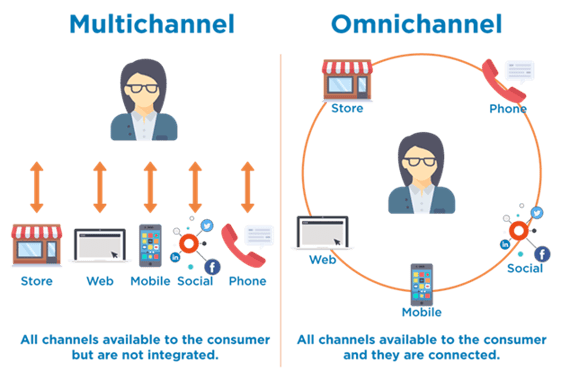What is omnichannel customer experience (CX)?
Due to technological advancements, it’s never been easier to buy a product or service. At the touch of a button, consumers can access countless platforms and browse to their heart's content. This is an advantage for any business looking to boost customer engagement and satisfaction, brand reputation, and sales.
The omnichannel customer experience refers to the provision of a unified experience across multiple platforms and devices. These platforms or channels include websites, social media, instant messaging, text messaging, etc.
Multichannel vs. omnichannel experience
These two approaches to marketing are often used interchangeably. However, they are distinct strategies. Let’s have a look at multichannel marketing before we compare it to omnichannel marketing.
As its name implies, multichannel marketing refers to the use of many channels. These can include voice, email, instant messaging, print, and physical stores. Multichannel marketing aims to make as many people aware of a brand as possible on various platforms.
The main difference between a multichannel and omnichannel experience is their focus. The first strategy focuses on each channel independently. It looks to provide a positive customer experience without bringing these channels together.
On the other hand, the omnichannel strategy is about harmonising these channels to provide a seamless customer experience. This is critical at a time when 90% of consumers demand omnichannel service.
 Source: Proactive Customer Service: What Is It and How to Do It
Source: Proactive Customer Service: What Is It and How to Do It
Measuring omnichannel customer experience strategy success with metrics and KPIs
Businesses are always looking for the best strategy to push them forward. However, it’s not enough just to adopt a good plan. You must determine whether it’s making a positive impact on your business. If it isn’t, you must identify the problem and find appropriate solutions.
Considering that the purchase rate of omnichannel campaigns is 287% higher than single-channel campaigns, implementing such a strategy is crucial.
Tracking metrics and KPIs (Key Performance Indicators) allows you to measure how well a strategy is working. However, not all of these fit the omnichannel context. For example, the perfect order rate wouldn’t be the most appropriate metric to use when looking to measure your success executing an omnichannel strategy, but rather the strength of your cross-team communications.
In this article, we’ll be sharing eight relevant metrics with you, as well as some best practices for improving the omnichannel customer experience.
Conversion Rates
The conversion rate refers to the percentage of website visitors who have completed a conversion (such as a purchase or subscription). In essence, the higher the conversion rate, the better your strategies are working.
To obtain this rate, use the following formula:
 Source: Effortless Experience is Key to Customer Loyalty
Source: Effortless Experience is Key to Customer Loyalty
This rate can be affected by your website’s design. To make this more appealing to users, you might look to provide a more personalised online experience. One of many effective website personalisation examples is implementing intelligent product recommendations.
Customer Satisfaction Score
The customer satisfaction score (CSAT) measures how satisfied a customer is with their experience with your brand. To obtain this score, customers are asked a question such as:
“On a scale of 1-5, how satisfied were you with your experience?”
Typically, one is "least satisfied" while five is "most satisfied". Ratings of four and five indicate satisfied customers, while three and below point to dissatisfaction. To calculate your CSAT, divide the number of satisfied customers by the total amount of answers obtained. You then multiply this by 100.
Customer Lifetime Value
Customer Lifetime Value (CLTV) measures how much a customer is likely to spend on a business or products over their lifetime. A higher CLVT indicates greater customer loyalty. Tracking the progression of CLTV can help you analyse customers’ shopping habits and target them with relevant material.
To see growth, you must make sure that your CLTV far exceeds your customer acquisition costs.
You can measure CLTV in a few ways:
- Total spend to date – Take the total value of a customer’s refunds away from the total value of their orders. This is a frequently used method but requires access to past data
- Predicted value – Multiply customers’ average spending per annum by the average customer lifetime. This can provide an idea of future spending trends
- Predicted lifetime spend – This is the sum of the above two values. This method helps in obtaining a more comprehensive insight into customer value

Net Promoter Score
The Net Promoter Score (NPS) involves asking customers the following:
“On a scale of 0-10, how likely are you to recommend this business brand to a friend or colleague?”
Answers to this question fall into one of three categories:
- Promoters – customers who responded with a 9 or 10. These are happy and typically loyal customers
- Passives – customers who gave a 7 or 8. While they are happy with their experience, they are not likely to contribute the word of mouth marketing your brand aims to inspire
- Detractors – customers who gave a score between 0 and 6. This group is dissatisfied with their experience. They could also discourage others from engaging with the brand. This should be dealt with quickly, as it can lead to negative reviews, which may heavily impact brand reputation; you should never underestimate the importance of online reviews!
The NPS can then be calculated as such:
NPS = (percentage of promoters – percentage of detractors)

Ticket Volume
Ticket volume refers to the total number of tickets in a company’s support queue over a certain period of time. This metric allows a brand to get an idea of their customer support situation. For instance, high ticket volume could mean that your customer service staff is not as productive as it could be. This may be a sign that you need to invest in a customer engagement platform.
Customer Loyalty Index
CLI measures customers' loyalty towards a brand over time. This is a tool that considers various factors. It involves asking three different questions:
- “How likely are you to recommend us to your friends and family?”
- “How likely are you to buy from us again in the future?”
- “How likely are you to try our other products?”
Customers can choose an answer from 1 – 6, with one being “Definitely Yes”, and six being “Definitely No”. A customer’s CLI is the average of their three answers.
Customer Effort Score
This metric tells you how much effort a customer must exert to interact with a business. The easier they find it, the more positive their overall experience is likely to be. They are then more likely to engage with the business and become repeat customers. Research has shown, in fact, that 96% of the consumers who reported having difficulty solving a problem were more disloyal.
This metric can be calculated by asking customers the following questions. For example:
“To what extent do you agree with the following – it was easy for me to purchase what I wanted.”
Customers can choose from five different options; typically, one is "Strongly disagree", and five is "Strongly agree".

Once you have your answers, you can use the following formula:
CES Score: (total sum of responses / number of responses)
The results can help you identify any issues. For instance, while a business’ physical store may be busy, its online presence could be weak. It may then be useful to seek out relevant methods, such as SEO data forecasting, to understand how you might drive more traffic to the website and help with page ranking.
Shopping Cart Abandonment Rate
This refers to the percentage of customers who didn’t complete a purchase, though they initially intended to do so. If this rate is high, there’s an issue that needs to be solved, such as poor website navigation or technical issues.
This rate can be calculated as follows:
Shopping Cart Abandonment Rate = (number of transactions initiated / number of transactions completed)
Best practices to improve omnichannel customer experience
There you have it - those were eight of the metrics and KPIs that can be used to measure the success of any omnichannel customer experience strategy. As a thank you for reading this far, here are some tips on how to improve the omnichannel customer experience.
Identify customer’s preferred platforms
Doing this makes you aware of where best to reach your customers and, therefore, which channels to focus on, thereby making your efforts more efficient.

Improve your response time
There’s nothing more frustrating than needing an answer and getting a response hours after you asked (if at all). Consumers are more likely to follow through with a purchase and become repeat customers when they feel supported in their use of your channels. This can lead to increased customer satisfaction.
Provide self-service options
These form part of a strong customer engagement strategy, creating user experiences that are valued by customers and include AI-powered chatbots, live chat, warehouse management software, and knowledge bases. Their use can improve your response time to customers and provide a more consistent service. In fact, it has been shown that 75% of consumers expect consistent experiences across channels.
Utilise analytics to make better business decisions
It’s not enough to collect data. You must analyse it and draw actionable conclusions from it. The metrics and KPIs discussed in this article are not helpful if the data gathered is not used to determine the success of a strategy and address any problem areas detected. For instance, the issue could be poor customer engagement, which can be remedied by considering steps to provide proactive customer support.
Takeaway
In today’s business world, the value of excellent customer service is high. The KPIs and metrics highlighted in this article are key when looking to perfect your omnichannel customer experience strategy.
Author Bio:
Grace Lau is the Director of Growth Content at Dialpad, an AI-powered cloud communication platform and cloud PBX solutions for better and easier team collaboration. She has over 10 years of experience in content writing and strategy. Currently, she is responsible for leading branded and editorial content strategies, partnering with SEO and Ops teams to build and nurture content. Here is her LinkedIn. She has also written for SurveyAnyplace and Cognism.
